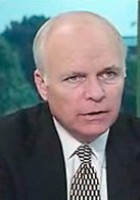Chairman and CEO, C-SPAN, 2000 Cable Hall of Fame
There was no cable news network… It had never been discussed; it had never been mentioned… I said to the group, my idea is that we figure out a way to do public affairs. That we do our own ‘Meet the Press’ type program, because cable has no identity to this.
Brian Lamb was born and raised in Lafayette, IN. By the time he graduated from Purdue University in 1963, he knew he loved two things: politics and the media. He began to see there was something wrong with the relationship between the two while he was serving in the Navy. Assigned to the Pentagon’s public affairs office, Lamb was able to listen to weekly press briefings given by Secretary of Defense Robert McNamara in his private dining room at the Pentagon. McNamara would divulge details about the war on condition that he only be quoted as “U.S. officials.” After each briefing, lead stories would appear in newpapers and on TV, revealing new developments in the war, but sourced only by “U.S. officials.”
To Lamb it seemed like a fraud, a relationship that allowed the government to control news about the war while handing reporters the stories they needed. Years later, when McNamara revealed he’d lied about many of the events of the war, the briefings seemed even more insidious.
At the White House Office of Telecommunications Policy in 1971, Lamb began to think about how cable, with its potential for many channels, might deliver a new kind of public affairs programming, one that favored longer, more informative interviews over the quick summaries that were becoming popular on network TV.
Then, on March 19, 1979, the Cable Satellite Public Affairs Network began beaming its signal. From the start, it was different from anything else on television, not just because of the live sessions of Congress it transmitted, but because of its approach to covering events. Cameras began rolling before a meeting or hearing started, showing people tapping microphones and getting ready to begin, and kept rolling after the event ended, while audiences gathered coats and began streaming toward the door.
His approach to interviewing people on the air was also radically different from what happened on most other TV outlets. He made it a rule that C-SPAN hosts never reveal their own opinions on the air.
C-SPAN’s approach to call-in shows, conceived in 1980, was still another departure. The calls weren’t just used to spice up a conversation between host and guest. They formed the backbone of the program, giving viewers a chance to talk back about issues.
C-SPAN continued to break rules for the next two decades, gaining particular fame in 1990, when it attached apel microphones to presidential candidates and followed them around for hours at a stretch, documenting the drama and mundane details of running for office.
C-SPAN added a second channel, C-SPAN2, in 1986 to cover proceedings of the U.S. Senate, and in 1989, it launched Booknotes, a weekly interview with non-fiction authors. The show would later spawn Book TV, a weekend program service on C-SPAN2 that is poised to expand as cable operators find room for more digital channels. C-SPAN Extra, a third channel offering more coverage of events, launched in 1999 and will be expanded to 24 hours a day this year.
Lamb, who several years ago delegated operating responsibilities for C-SPAN to executive vice presidents Susan Swain and Rob Kennedy, serves as the organization’s chief standard-bearer and liaison with its cable industry board of directors. He keeps up a demanding schedule that includes hosting Booknotes 52 weeks a year and the weekly hosting of Washington Journal, the network’s flagship morning call-in show. He travels to numerous speaking engagements and refuses compensation for them. Earnings from his books, the third of which is a tour of presidential grave sites, go to C-SPAN’s education foundation.





